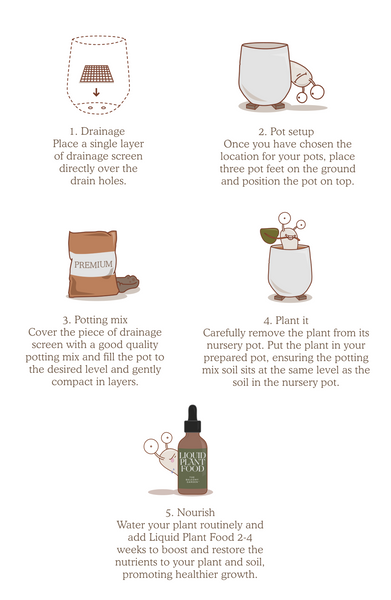How to Pot a Plant - The Ultimate Slugg® Guide
Welcome to our ultimate guide on potting up your plants! Whether you're using Slugg® pots with a drainage kit or trays, we've got you covered.
Drainage Kit or Pot Trays?
Slugg® recommends two methods for potting your plants: the 'drainage kit' for outdoor plants aiming for a permanent spot OR 'pot trays' for indoor use to prevent messy spills and also ensure your plants can easily be taken out of their Slugg® pot.
How to Use Your Drainage Kit:
The key to thriving plants is proper drainage. Most plants hate wet feet, especially in garden pots. It causes rotting, invites pests and can lead to diseases. There are three components of good drainage:
-
Drainage Screen: Cover the drainage holes with a screen to prevent soil from falling through while allowing water to pass freely.
-
Pot Feet: Elevate the pot using pot feet to ensure excess water drains away and minimises floor staining.
-
Potting Mix: Use a quality potting mix designed for garden pots, and avoid compaction by rinsing the soil once it's in the pot.

How to Use Your Pot Trays:
Trays are ideal for indoor plants; however, regular maintenance is essential. Here's how:
-
Insert Trays: Match tray sizes with corresponding Slugg® pots and place them inside.
-
Add Plants: Keep your plant in its nursery pot and place it within the Slugg® pot, ensuring it sits neatly on the tray.
-
Maintenance: Regularly clean trays to prevent water build-up, mould, and pests.
Finishing Touches to Your Plants:
Finally, give your plant a good soaking; this will tell you if you need more soil around the root ball due to compaction (if using a drainage kit). We highly suggest maintaining your plants with good-quality fertiliser like this Liquid Plant Food every 2-4 weeks to boost and restore nutrients to your plant and soil, promoting healthier growth.
Didn't purchase a Tray or Drainage Kit? You can purchase these individual items from most hardware stores to make your own kits.